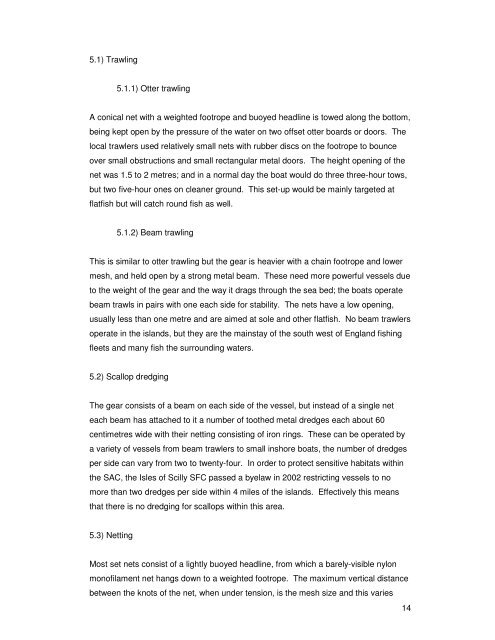Isles of Scilly Fish and Fisheries - Cornwall Wildlife Trust
Isles of Scilly Fish and Fisheries - Cornwall Wildlife Trust
Isles of Scilly Fish and Fisheries - Cornwall Wildlife Trust
Create successful ePaper yourself
Turn your PDF publications into a flip-book with our unique Google optimized e-Paper software.
5.1) Trawling<br />
5.1.1) Otter trawling<br />
A conical net with a weighted footrope <strong>and</strong> buoyed headline is towed along the bottom,<br />
being kept open by the pressure <strong>of</strong> the water on two <strong>of</strong>fset otter boards or doors. The<br />
local trawlers used relatively small nets with rubber discs on the footrope to bounce<br />
over small obstructions <strong>and</strong> small rectangular metal doors. The height opening <strong>of</strong> the<br />
net was 1.5 to 2 metres; <strong>and</strong> in a normal day the boat would do three three-hour tows,<br />
but two five-hour ones on cleaner ground. This set-up would be mainly targeted at<br />
flatfish but will catch round fish as well.<br />
5.1.2) Beam trawling<br />
This is similar to otter trawling but the gear is heavier with a chain footrope <strong>and</strong> lower<br />
mesh, <strong>and</strong> held open by a strong metal beam. These need more powerful vessels due<br />
to the weight <strong>of</strong> the gear <strong>and</strong> the way it drags through the sea bed; the boats operate<br />
beam trawls in pairs with one each side for stability. The nets have a low opening,<br />
usually less than one metre <strong>and</strong> are aimed at sole <strong>and</strong> other flatfish. No beam trawlers<br />
operate in the isl<strong>and</strong>s, but they are the mainstay <strong>of</strong> the south west <strong>of</strong> Engl<strong>and</strong> fishing<br />
fleets <strong>and</strong> many fish the surrounding waters.<br />
5.2) Scallop dredging<br />
The gear consists <strong>of</strong> a beam on each side <strong>of</strong> the vessel, but instead <strong>of</strong> a single net<br />
each beam has attached to it a number <strong>of</strong> toothed metal dredges each about 60<br />
centimetres wide with their netting consisting <strong>of</strong> iron rings. These can be operated by<br />
a variety <strong>of</strong> vessels from beam trawlers to small inshore boats, the number <strong>of</strong> dredges<br />
per side can vary from two to twenty-four. In order to protect sensitive habitats within<br />
the SAC, the <strong>Isles</strong> <strong>of</strong> <strong>Scilly</strong> SFC passed a byelaw in 2002 restricting vessels to no<br />
more than two dredges per side within 4 miles <strong>of</strong> the isl<strong>and</strong>s. Effectively this means<br />
that there is no dredging for scallops within this area.<br />
5.3) Netting<br />
Most set nets consist <strong>of</strong> a lightly buoyed headline, from which a barely-visible nylon<br />
mon<strong>of</strong>ilament net hangs down to a weighted footrope. The maximum vertical distance<br />
between the knots <strong>of</strong> the net, when under tension, is the mesh size <strong>and</strong> this varies<br />
14

















